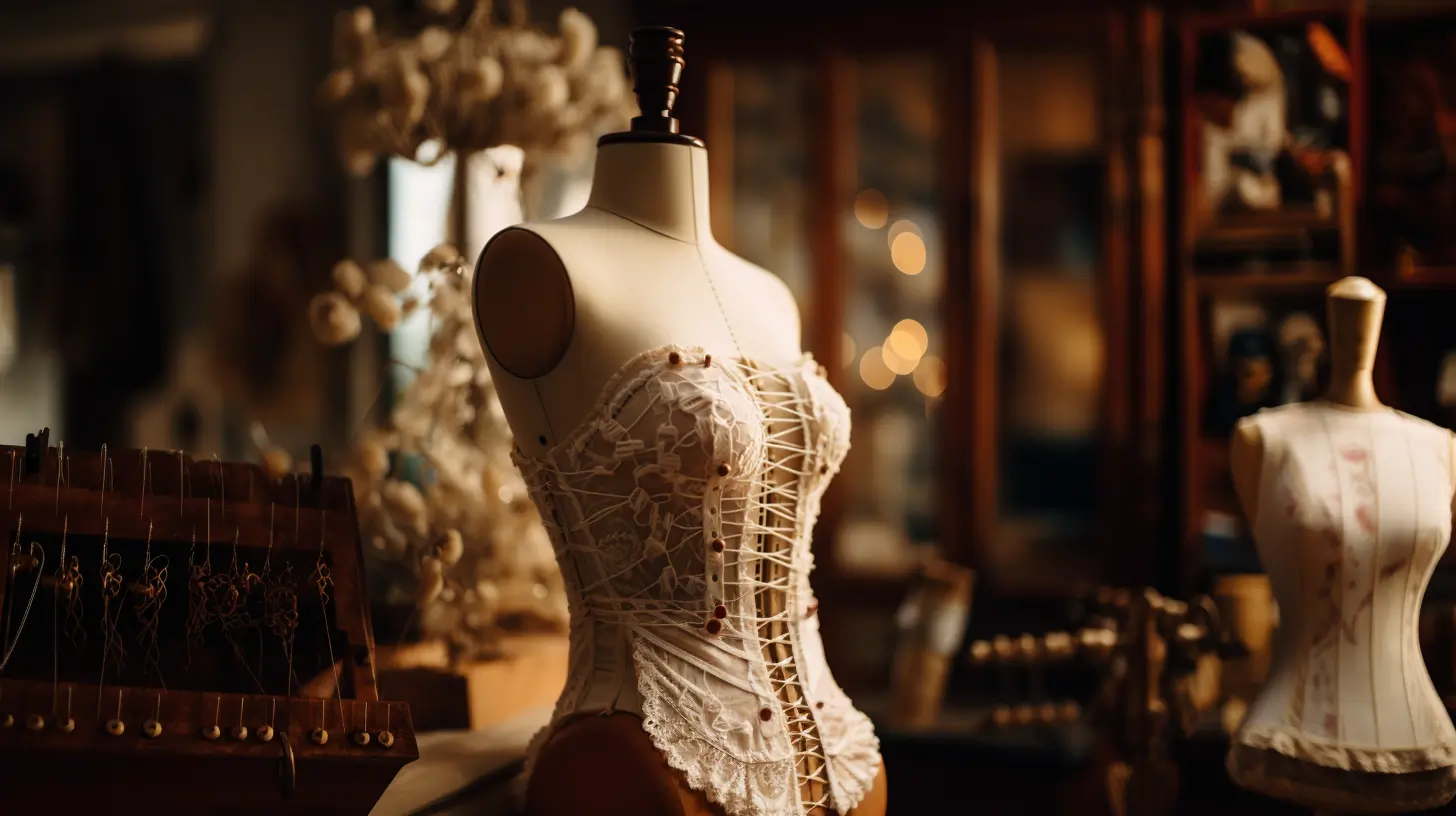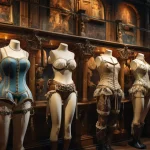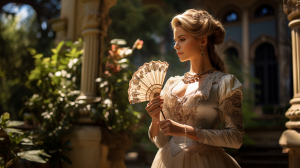
A Glimpse Beneath the Silks and Brocades
Ah, my dearest readers, today we embark on a mesmerizing journey beneath the extravagant layers of Baroque and Rococo fashion. Yes, we’re diving deep into the sumptuous world of Baroque and Rococo undergarments. As you meander through luscious palaces adorned with gilded ornaments, imagine yourself in an opulent ballroom filled with the rich textures of silk, satin, and lace. Now, let’s pull back the curtains, quite literally, and uncover what lies beneath those ornate gowns and tailored suits.
You see, fashion is akin to an onion, layered and complex, and each layer tells a tale of its own. The undergarments of the Baroque and Rococo periods are no exception. They’re the unsung heroes, the clandestine artisans that shape, mold, and define the outer spectacle. By understanding these undergarments, we can more deeply appreciate the artistry and societal complexities of these bygone eras.
From whalebone corsets that cinched waists into hourglass figures, to the cravats that adorned the necks of gentlemen, each piece had its purpose, be it aesthetic, functional, or symbolic. And often, these purposes were interwoven with the cultural tapestry of the time, intricately stitched with threads of social norms, economic statuses, and gender roles.
🎨 Image Description: A photorealistic illustration capturing the intimacy of a Baroque dressing room. A meticulously crafted corset lays on an antique wooden table, beside it a delicate cravat. These undergarments, although hidden from public view, shine in their own right, embellished with fine lace and intricate embroidery. The image invites you to consider what lies beneath the outer layers of grandeur.
So, let us leave no stone unturned, or in this case, no lace unexamined, as we explore this often overlooked yet significant chapter in fashion history.
The Invisible Artisans: Crafting Baroque and Rococo Foundations
As we step through the intricate labyrinth of Baroque and Rococo fashion, we find that the undergarments of these eras are far more than mere utilities. They are, in fact, works of art, sculpting the body into fashionable silhouettes that express the ideals and aspirations of their times.
Corsetry: The Architecture of Femininity
The corset, that enduring symbol of feminine allure, was not merely an accessory in the Baroque and Rococo periods but a cornerstone of women’s fashion. Crafted meticulously from layers of fabric and often reinforced with whalebone or metal, the corset shaped and molded the upper body, transforming the wearer into an epitome of the societal beauty standards. They were laced tightly, sometimes to the point of discomfort, but always with an eye for achieving the most coveted hourglass figure. The high level of craftsmanship invested in corsets reflects not just the aesthetic ambitions but also the practical needs of women during these periods.
🖼️ Image Placeholder: A detailed illustration showcasing a Baroque-era corset from multiple angles, highlighting its construction and the materials used. The boning channels, the lace details, and the intricate patterns all stand out, telling the tale of its craftsmanship.
Panniers: Expanding the Realm of Possibility
While corsets focused on cinching, panniers aimed to expand. Worn on either side of the hips and typically made of stiff materials like wood or whalebone, panniers allowed skirts to billow outwards in a grand display of fabric and finery. The larger the pannier, the wealthier or higher-ranking the woman. By understanding the varying sizes and shapes of these panniers, we can gain insights into the social hierarchies and distinctions of the time.
The Gentleman’s Cravat: Subtlety and Statement
When considering men’s fashion in these periods, the cravat emerges as a quintessential item. This precursor to the modern tie served both functional and decorative purposes. Made from fine materials like silk or lace, it was often adorned with intricate embroidery or jewel embellishments. Far more than a neck accessory, the cravat communicated a man’s social status, his fashion sensibilities, and occasionally, his political affiliations.
The Underpinnings of Culture and Class
Baroque and Rococo undergarments were not merely practical necessities but encoded cultural and social messages. Through the lens of these garments, one can delve into the complexities of gender roles, social stratifications, and even the economic climate. Were the fabrics locally sourced or imported? Were they mass-produced or individually tailored? Each stitch and seam narrates a tale worth exploring.
Woven Narratives: The Fabrics of Baroque and Rococo Undergarments
Let’s talk fabrics—the stuff that brings form to function and turns concept into reality. In the extravagant epochs of Baroque and Rococo, the choice of fabric in undergarments wasn’t just a matter of taste, but also one of status, access, and often, audacity. From silk to muslin, from cotton to linen, each material had its role, its place, and its story.
Silk: The Ultimate Luxe
Silk was the pinnacle of luxury when it came to Baroque and Rococo undergarments. Sourced from the exotic silkworm, often via intricate trade routes, it represented opulence and grandeur. Lush, smooth, and incredibly lightweight, silk had thermal properties that made it both cool in the summer and warm in the winter. It wasn’t just about comfort; it was a statement.
Cotton and Linen: The Workhorse Fabrics
Don’t underestimate the power of the basics. Cotton and linen may not have the high-society allure of silk, but they were the backbone of everyday undergarments. Breathable and more affordable, these fabrics were ideal for everyday corsets and cravats, especially for the working class. Linen had the added advantage of being durable and naturally antimicrobial, making it a sensible choice for those long days at court or on the farm.
Muslin: The Intricate Middle Ground
Muslin occupies an interesting niche. Finer than cotton but less ostentatious than silk, this fabric was often used for creating undergarments that were both comfortable and pretty. Its lightweight and breathable nature made it a favorite for summer wear. Muslin could be easily dyed and adorned with lace, ribbon, or embroidery, providing a canvas for artistic expression even in the most intimate layers of clothing.
🖼️ Image Placeholder: An illustration depicting swatches of Baroque and Rococo-era fabrics—silk, cotton, linen, and muslin—laid out elegantly next to a historical sewing kit. Each fabric swatch should exhibit its unique texture and possible color palette, offering a tactile and visual treat.
The Politics of Fabric Choice
Materials weren’t just materials; they were markers of geopolitical developments and trade relations of the era. The sourcing of silk, for example, could often be linked back to diplomatic alliances or colonial endeavors. Cotton and linen, on the other hand, signaled domestic production and local economies. Fabric choices were thus not just individual but collective decisions, echoing the broader socio-political context.
Stitching Time: The Sewing Techniques That Defined Baroque and Rococo Undergarments
Let’s delve deep into the heart of the matter—sewing techniques. Behind the dazzling show of fabrics and embellishments lay the unsung heroes of Baroque and Rococo fashion: the stitches and seams that held it all together. Through intricate craftsmanship, those delicate fabrics were transformed into structural masterpieces. From traditional to ornamental, let’s explore the various sewing techniques employed to craft these incredible undergarments.
The Backbone: Boning and Busks
Before the invention of elastic or spandex, boning and busks were the literal backbone of undergarments. They provided the structure and shape, particularly in corsets. Boning was often crafted from whalebone, although reed or baleen were popular as well. Busks, usually made of wood, ivory, or bone, were inserted into the front of the corset to maintain its rigid form.
Running Stitches and Backstitches: The Unsung Heroes
These were the most common types of stitches used. Running stitches for the lesser load-bearing seams and backstitches for the more stressed points. While simple, these basic stitches had to be executed with utmost precision. A running stitch gone awry or a backstitch out of line could compromise the whole garment. This is where the true skill of the tailor or seamstress came into play.
🖼️ Image Placeholder: A close-up illustration of various sewing techniques. Display the difference between running stitches and backstitches. Include representations of boning and busks, illustrating how they were integrated into the structure of a corset.
Embroideries and Lace: The Ornaments of Elegance
These techniques were not just functional but also decorative. Embroideries often adorned the edges of undergarments, lending them a touch of elegance and opulence. Lace was another common decorative element. It adorned the edges of cravats, panniers, and even the upper rims of corsets. These were not just frills; they were a canvas for the craftsman’s skill, a mark of quality, and a testament to the wearer’s taste and status.
Patchwork and Repair: A Testament to Sustainability
In an era when garments were labor-intensive and costly, repairs were commonplace. Patchwork quilting or darning were often employed to extend the lifespan of these undergarments. Though less glamorous than embroidery or lace, this practice was a testament to the sustainability and pragmatism of the times.
Accessories and Accoutrements: The Hidden Charms of Baroque and Rococo Undergarments
Ah, the Baroque and Rococo periods, times of unabashed opulence. Yet, beneath the grandiosity of the outer layers, the undergarments carried their own form of intrigue. These were not merely pieces of cloth but hidden worlds with their own set of rules and etiquette. From delicate pocket hoops to seductive fans, let’s unravel the allure of these intimate add-ons.
🎀 Ribbons and Bows: Tying the Knot of Sophistication 🎀
Ribbons, often made of silk or satin, were more than mere decoration. In the delicate landscape of Baroque and Rococo undergarments, they played a vital role. Tied carefully around waists or used to adjust the fit of a corset, ribbons were both functional and ornate. The color and quality of the ribbon also conveyed subtle messages about social standing and personal taste.
📿 Beads and Baubles: The Understated Jewelry 📿
Yes, jewelry had a place even in the world of undergarments. Tiny beads made of glass, pearl, or even semi-precious stones, adorned corset laces and the hems of underskirts. While not immediately visible to the casual observer, these little touches were an intimate form of self-expression, treasured and sometimes even monogrammed by the wearer.
🖼️ Image Placeholder: A luxurious still-life painting depicting an assortment of Baroque and Rococo undergarment accessories. Showcase ribbons, beads, and other minor decorations laid out on a draped silk fabric.
🌺 Scent Pockets and Pomanders 🌺
In an era where bathing was not as frequent as today, scent pockets filled with herbs and pomanders dangled discreetly inside these undergarments. They were carefully sewn into the inner layers or attached to a girdle, filling the air around the wearer with subtle fragrances like lavender or rosemary.
🕊️ Feathers and Frills: The Final Flourish 🕊️
Feathers often found their way into the fashion of the Baroque and Rococo periods, and the undergarments were no exception. Ostrich or peacock feathers were sometimes sewn into the interior of panniers or cravats, adding a final flourish and a secret sense of extravagance known only to the wearer and perhaps a select few.
The Anatomy of a Cravat: Knots and Nuances
The cravat, an accessory often overlooked, possesses an allure that should not be underestimated. It has graced the collars of kings and revolutionaries, soldiers and artists. Its humble origins belie its intricate influence on fashion and culture. Come, let us explore the very fabric that shapes our understanding of Baroque and Rococo undergarments.
👔 The Genesis of the Cravat 👔
Contrary to popular belief, the cravat did not emerge as a fashion statement but rather from a utilitarian purpose. Originating in 17th-century Croatia as a piece of cloth tied around soldiers’ necks, it evolved into a staple in the French court. This simple strip of fabric evolved into elaborate patterns and embroideries, eventually integrating itself into the very sinews of Baroque and Rococo undergarments.
📜 Types of Fabric: From Silk to Linen 📜
When you consider the kinds of fabrics used in cravats during these opulent eras, you’ll find a range from simple linen to luxurious silk. Linen cravats were more functional, often worn by commoners and military men, while silk cravats with intricate embroidery were the prized possessions of aristocrats.
🖼️ Image Placeholder: A hyper-realistic painting illustrating various fabrics used in cravats—linen, silk, and even lace. The fabrics should be intricately detailed to show their unique textures.
🌀 Knots and Folds: The Art of Tying a Cravat 🌀
Ah, the art of knotting a cravat. It wasn’t as straightforward as one might think. There were specific knots designated for different occasions, from formal gatherings to casual outings. The more elaborate the knot, the higher the status of the wearer was often assumed to be.
🌐 The Cultural Impact of the Cravat 🌐
The cravat did more than just adorn necks; it became a symbol of the era’s social hierarchy and norms. It even crossed oceans and influenced American and British fashion. During the Baroque and Rococo periods, your choice of cravat and how you wore it made a statement about your social standing, your political beliefs, and even your romantic pursuits.
Layers of Secrecy: The Hidden Stories of Petticoats
Gather around, dear readers, as we journey back in time to explore another fascinating facet of Baroque and Rococo undergarments—the petticoat. This undergarment, so unassuming at first glance, holds more stories and secrets than one might imagine.
🌸 The Humble Beginnings 🌸
Contrary to popular imagination, the petticoat was not exclusive to women. During its early years in the 16th century, it was a unisex garment. Worn for warmth and comfort, it started out as a practical item rather than a fashion statement. As time passed and the societal norms of the Baroque and Rococo periods took hold, the petticoat transformed, accruing layers of meaning and material alike.
🎀 Fabric Choices and Their Significance 🎀
Let’s delve into the fabric of the matter. During the Baroque and Rococo eras, petticoats were made from a range of materials, including cotton, linen, and silk. A woman’s choice in fabric was often a status symbol; silk petticoats, for instance, were highly valued and usually worn by the upper echelons of society. Cotton and linen, on the other hand, were more common among the working class.
🖼️ Image Placeholder: Imagine an oil painting depicting three women from different social classes, each lifting their outer skirts slightly to reveal the petticoat underneath. The image should showcase the texture and patterns of the different fabrics used.
🗝️ Layers and Layers: The Petticoat as a Concealer 🗝️
Intriguingly, petticoats served a secondary purpose: that of concealing items and even messages. Women have been known to sew pockets between the layers, using the garment as a secretive storage place. It was not uncommon for love letters, small weapons, or important documents to be concealed in these hidden layers.
🌍 Influence Beyond Borders 🌍
Like the cravat, the petticoat had its own cultural impact. Not confined to European fashion, it spread its influence to colonial territories. Adaptations of the petticoat could be found in various cultures around the world, each adding their unique touch, be it in the form of indigenous embroidery or localized fabric choices.
The Understated Elegance of the Stomacher: The Crown Jewel of Baroque and Rococo Undergarments
Let’s gently peel away yet another layer of this intriguing narrative. Ah, the stomacher, an article of clothing whose name alone may be unfamiliar to many. Despite its modest obscurity, it tells us an absorbing tale that sweeps across the centuries, much like the intricate lace and embroidery it often boasts.
✨ Jewels, Laces, and Ribbons: Crafting the Stomacher ✨
Artistry has never been quite so close to the heart—literally. Positioned over the chest, the stomacher was often the most ornate part of a woman’s attire. Craftsmen and seamstresses poured their souls into creating intricate designs, using an assortment of materials from silk and satin to pearls and precious stones.
🌹 Floral Imprints: The Language of Flowers 🌹
When flowers weren’t just flowers, but whispers of secret longings and messages, their imprints on stomachers spoke volumes. Floral patterns often had symbolic meanings. A rose, for instance, signaled love and passion, while violets were suggestive of loyalty and humility.
🎭 Theatrical Flair: Stomachers on Stage 🎭
No, this garment was not relegated solely to everyday wear. It enjoyed its fair share of limelight, frequently featured in theatrical costumes. The sparkle of gemstones and the glint of metallic threads under stage lights turned stomachers into eye-catching pieces that held the audience’s gaze as compellingly as the performance itself.
🖼️ Image Placeholder: Envision a highly detailed photograph capturing the top-down view of a stomacher. The lighting is soft, yet it casts a luminescent glow over the pearls and gemstones intricately sewn onto the fabric, making them sparkle in a manner almost magical.
💡 The Evolution: Adapting to Changing Times 💡
Fashion, as you know, is never stagnant. Neither was the stomacher. As the eras changed, so did this captivating garment. Once a staple of upper-class fashion, it later transitioned into a more accessible item, embracing a variety of fabrics and designs.
The Revolution of the Corset: Tightening the Social Fabric
Lean in a bit closer, for what we unravel next is more than mere fabric and strings; it’s an archive of societal beliefs, steeped in tradition, yet pulsating with change. We delve into the mystique of the corset, an iconic garment that has undergone transformations as intricate as the laces that hold it together.
🌐 Global Influences: The Corset’s Diverse Heritage 🌐
The corset wasn’t just the offspring of European high society. This garment, in fact, had an exotic lineage, incorporating elements from various cultures. The stiffened bodices found in Spanish court attire, the busks from African tribal wear, and the intricate lacing patterns derived from Asian textiles all contributed to the corset’s rich history.
📜 Period Pieces: The Corset Through the Ages 📜
No other garment can claim to have lived through as many epochs, each leaving its indelible mark. In the Elizabethan era, the corset was a work of geometric precision, mirroring the rigid societal norms. The Romantic period softened its edges, introducing a more natural silhouette. By the time the flappers of the 1920s swung by, the corset had evolved into less constraining undergarments, echoing the liberation movements of the time.
💪 Feminine Strength: The Corset as Power Armor 💪
Countering the criticism often aimed at corsets as oppressive garments, many women found empowerment in the shaping and sculpting that a corset provided. Not merely a tool for achieving the “ideal” figure, it was also a canvas for self-expression, lavishly decorated and personalized.
🖼️ Image Placeholder: Picture a corset on a vintage dress form, illuminated by a soft light that highlights its intricate laces and detailed embroidery. Placed against a dark background, the corset almost glows, symbolizing both constriction and liberation.
💃 The Corset in Pop Culture: From Silver Screens to Red Carpets 💃
The corset’s influence isn’t just historical; it’s incredibly current. Major movies, television series, and even red carpet events are showcasing corsets in new, groundbreaking ways. Whether it’s a nod to historical accuracy or a rebellious statement against modern fashion norms, the corset remains as relevant as ever.
The Strings That Bind: Unraveling the Intricacies of the Corset
So, my friends, we find ourselves at the point where the threads of our discussion converge. A garment as complex as the corset deserves a worthy send-off. Indeed, there’s more to this enigmatic piece of clothing than steel boning and lace. It’s a narrative stitched into the very fabric of human history and society.
🌱 The Legacy: The Corset’s Impact on Contemporary Fashion 🌱
One can’t underestimate the corset’s indelible influence on modern fashion. It’s not just a period piece or a costume; it’s a fashion staple that has been reimagined for today’s world. You see, the corset now takes many forms. It is the structured bodice of an evening gown, the bold statement piece on a runway, and even the casual waist-trainer used by fitness enthusiasts. Each iteration tells a different story, yet they all draw from the same rich tapestry of history.
🛠️ DIY Corsetry: Crafting Your Narrative 🛠️
For those who wish to engage more intimately with this captivating garment, why not try your hand at creating your own corset? Not merely a craft but an art form, making a corset requires a keen eye for detail and a patient hand. You’ll need quality fabric, strong boning, and of course, the iconic laces. The process is involved, but the reward is a unique piece that is both a fashion statement and a form of self-expression.
💫 Conclusion: The Eternal Allure of the Corset 💫
There’s a timeless quality to the corset, a charm that doesn’t fade with the turning pages of calendars. For every era it has passed through, it has left a mark—sometimes subtle, sometimes revolutionary. As we dress for the future, let us not forget the layers of the past that offer shape and substance to our present. For in every cinch and lace, in every tug and pull, we find a piece of ourselves, and a connection to the countless others who have felt the same embrace.
Unearthing the Deep-Rooted Legacy of the Corset
So, here we are, at the conclusion of our journey—a journey that’s taken us through the fabric of time and the tightly cinched world of corsets. We’ve gone deep into the art, the mechanics, and the legacy of this enigmatic garment. I suppose the truth is, no one piece of clothing can encapsulate an entire culture, an entire era. But some damn well try.
A Stitch in Time: The Corset’s Historical Prowess
We kicked off by diving into the evolution of the corset, a subject rich with history and saturated with the weight of societal norms. From the rigid confines of Victorian sensibilities to the more liberated expressions of the modern day, the corset has worn many faces. And like a well-seasoned dish, its essence only deepens with each incarnation.
Pop Culture & Strings Attached
The corset isn’t confined to museums or period dramas; it has its own walk of fame in modern fashion and pop culture. From the red carpets to magazine covers, from pop music videos to high fashion runways, the corset is everywhere. It’s a symbol, a statement, a banner carried forward by those who dare to defy, or perhaps define, the conventional norms.
The Craft Behind the Curve
And what would our journey be if we didn’t roll up our sleeves and get our hands dirty? The craftsmanship required to produce these works of art is something to be admired, like a dish that’s intricate yet simple. Each thread, each stitch is a note in a greater symphony—one that requires not just a set of skilled hands but an understanding of the material, much like a chef understands his ingredients.
Image Placeholder: A close-up image showcasing the intricate stitching and craftsmanship of a handmade corset, capturing the fine details that would make any craftsman proud.
The Corset: A Personal Narrative
Perhaps, the most intriguing aspect is how the corset has evolved into a form of self-expression. It isn’t just an item of clothing; it’s a narrative, a story woven into fabric and tightened with strings, one that each wearer tailors to fit their own life’s tapestry. And isn’t that what all great legacies aspire to be? Stories that continue to be retold, long after their authors are gone.
In the grand scheme of things, the corset is but a garment—a collection of fibers and fabrics that, by all accounts, should mean very little. Yet, here we are, enamored by its complexity, captivated by its story. It’s more than just a fashion statement; it’s a historical document, a societal commentary, a work of art, and a personal narrative all cinched into one.








